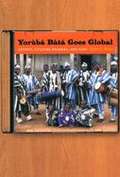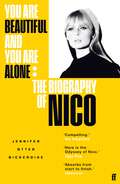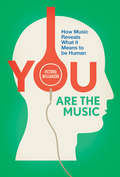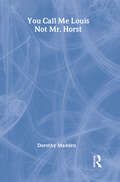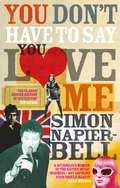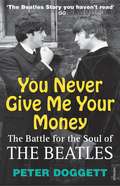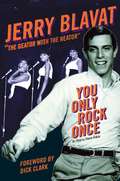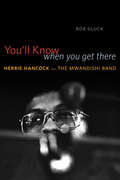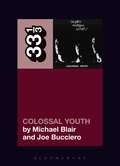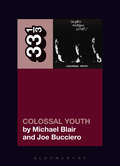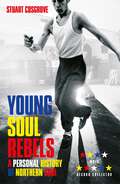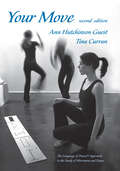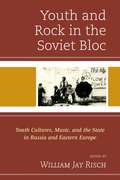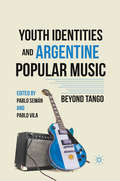- Table View
- List View
Yorùbá Bàtá Goes Global: Artists, Culture Brokers, and Fans
by Debra L. KleinResponding to growing international interest in the Yorùbá culture of southwestern Nigeria, practitioners of bàtá—a centuries-old drumming, dancing, and singing tradition—have recast themselves as traditional performers in a global market. As the Nigerian market for ritual bàtá has been declining, international opportunities for performance have grown. Debra L. Klein’s lively ethnography explores this disjunction, revealing the world of bàtá artists and the global culture market that helps to sustain their art. Yorùbá Bàtá Goes Global describes the dramatic changes and reinventions of traditional bàtá performance in recent years, showing how they are continually recreated, performed, and sold. Klein delves into the lives of Yorùbá musicians, focusing on their strategic collaborations with artists, culture brokers, researchers, and entrepreneurs worldwide. And she explores how reinvigorated performing ensembles are beginning to parlay success on the world stage into increased power and status within Nigeria. Klein’s study of the interwoven roles of innovation and tradition will interest scholars of African, global, and cultural studies, anthropology, and ethnomusicology alike.
Yoruba Oral Tradition in Islamic Nigeria: A History of Dàdàkúàdá (Global Africa)
by Abdul-Rasheed Na'AllahThis book traces Dàdàkúàdá’s history and artistic vision and discusses its vibrancy as the most popular traditional Yoruba oral art form in Islamic Africa. Foregrounding the role of Dàdàkúàdá in Ilorin, and of Ilorin in Dàdàkúàdá the book covers the history, cultural identity, performance techniques, language, social life and relationship with Islam of the oral genre. The author examines Dàdàkúàdá’s relationship with Islam and discusses how the Dàdàkúàdá singers, through their songs and performances, are able to accommodate Islam in ways that have ensured their continued survival as a traditional African genre in a predominantly Muslim community. This book will be of interest to scholars of traditional African culture, African art history, performance studies and Islam in Africa.
Yoruba Oral Tradition in Islamic Nigeria: A History of Dàdàkúàdá (Global Africa)
by Abdul-Rasheed Na'AllahThis book traces Dàdàkúàdá’s history and artistic vision and discusses its vibrancy as the most popular traditional Yoruba oral art form in Islamic Africa. Foregrounding the role of Dàdàkúàdá in Ilorin, and of Ilorin in Dàdàkúàdá the book covers the history, cultural identity, performance techniques, language, social life and relationship with Islam of the oral genre. The author examines Dàdàkúàdá’s relationship with Islam and discusses how the Dàdàkúàdá singers, through their songs and performances, are able to accommodate Islam in ways that have ensured their continued survival as a traditional African genre in a predominantly Muslim community. This book will be of interest to scholars of traditional African culture, African art history, performance studies and Islam in Africa.
You Are Beautiful and You Are Alone: The Biography of Nico
by Jennifer Otter BickerdikeA redemptive, myth-shattering biography of one of the twentieth century's most underestimated creative and artistic forces.'Here is the Odyssey of Nico . . . a scholarly and detailed chronicle of this brilliant artist, who was spurned and tortured for her trouble.'IGGY POP'At last, a comprehensive and compelling book about Nico.'VIV ALBERTINE'A gripping portrait.' THE TIMES'Absorbs from start to finish.' OBSERVER'Entertainingly written and insightful.' INDEPENDENT'Detailed and sympathetic.' EVENING STANDARD'Expansive.' UNCUT'Compassionate.' MOJOThe real story of Nico is one of determination, self-destruction and belief in one's artistic vision, at any cost.Nico was an ever-evolving myth, an enigma that escaped definition.Born Christa Päffgen, Nico grew up in war-torn Berlin before being scouted by a fashion photographer in her early teens. At age twenty-seven, she became Andy Warhol's newest Superstar, securing the position of chanteuse for the Velvet Underground. Though she is primarily remembered for contributions to their seminal debut album - and her relationships with Brian Jones, Bob Dylan and Jim Morrison - her own artistry and influence have often been overlooked.Nico spent most of her career as a solo artist on the road, enduring empty concert halls, abusive fans and the perilous reality of being a drug addict. Yet beneath the superficial denigrations and one-dimensional myths was a complicated visionary determined to make art that was truly her own.In You Are Beautiful and You Are Alone, defying the sexist casting of her life as the tragedy of a beautiful woman losing her looks, youth and fame, Jennifer Otter Bickerdike cements Nico's legacy as one of the most vital artists of her time, inspiring a generation of luminaries including Björk, Morrissey and Iggy Pop.Containing over a hundred new interviews and rare archival material, this is an empowering reappraisal of an underappreciated icon.'The book that Nico's real devotees have been waiting for, and this unique lady has long deserved, deserves to sit with the great biographies.'RECORD COLLECTOR (*****)'Scrapes away decades of "misogyny and stereotyping" to reveal something of the woman behind the cheekbones . . . Bickerdike battles hard to bring light to the darker corners of Nico's story; she busts myths, tracks down documents and tries to explain the singer's motivations.'UNCUT'Riveting.' BARNEY HOSKYNS'Extraordinary.' GILLIAN McCAIN'Vivid, moving, unsettling.' LUCY O'BRIEN'What a treasure this book is.' DANNY FIELDS
You Are the Music: How Music Reveals What it Means to be Human
by Victoria Williamson'You are the music / While the music lasts' T.S. Eliot, The Four Quartets Do babies remember music from the womb? Can classical music increase your child’s IQ? Is music good for productivity? Can it aid recovery from illness and injury? And what is going on in your brain when Ultravox’s ‘Vienna’, Schoenberg’s Verklärte Nacht or Dizzee Rascal’s ‘Bonkers’ transports you back to teenage years? In a brilliant new work that will delight music lovers of every persuasion, music psychologist Victoria Williamson examines our relationship with music across the whole of a lifetime. Along the way she reveals the amazing ways in which music can physically reshape our brains, explores how ‘smart music listening’ can improve cognitive performance, and considers the perennial puzzle of what causes ‘earworms’. Requiring no specialist musical or scientific knowledge, this upbeat, eye-opening book reveals as never before the extent of the universal language of music that lives deep inside us all.
You Call Me Louis, Not Mr. Horst
by Dorothy MaddenDorothy Madden's lively book about Louis Horst (You don't call me Mr. Horst, you call me Louis, he always said) makes for compulsive reading. She follows Horst's extraordinary life, punctuating her narrative with reminiscences, illuminating anecdotes from her personal store of memories, as well as the shared thoughts of others, all interspersed with her choice of evocative and expressive photographs and illustrations, to create a dynamic and memorable portrait of this key figure in American modern dance. Louis Horst: musician, composer, pianist, violonist, pit player, arranger, super accompanist (all sorts), conductor, régisseur, stage manager, tour tartar, catalyst, editor, writer, critic, teacher, consoler, the Sherlock Holmes of restaurants, keeper of journals and budgets, loan provider, lover, friend...
You Call Me Louis, Not Mr. Horst
by Dorothy MaddenDorothy Madden's lively book about Louis Horst (You don't call me Mr. Horst, you call me Louis, he always said) makes for compulsive reading. She follows Horst's extraordinary life, punctuating her narrative with reminiscences, illuminating anecdotes from her personal store of memories, as well as the shared thoughts of others, all interspersed with her choice of evocative and expressive photographs and illustrations, to create a dynamic and memorable portrait of this key figure in American modern dance. Louis Horst: musician, composer, pianist, violonist, pit player, arranger, super accompanist (all sorts), conductor, régisseur, stage manager, tour tartar, catalyst, editor, writer, critic, teacher, consoler, the Sherlock Holmes of restaurants, keeper of journals and budgets, loan provider, lover, friend...
You Don't Have To Say You Love Me
by Simon Napier-BellYou probably know Simon Napier-Bell as the manager of the Yardbirds. Or you may know him as the man who managed Marc Bolan, or Japan. You should definitely know him as the man who managed Wham! And if none of these rings a bell, maybe you'll remember him as the man who co-wrote 'You Don't Have To Say You Love Me' for Dusty Springfield. You Don't Have To Say You Love Me is one of the funniest books you will read and equally provoking. From his revelation that the entire music industry was motivated by sex, to an embarrassing come-on from a suicidal Brian Epstein, it's all shocking stuff. But when you're on the run from the German police with Marc Bolan, brothel-hopping with Keith Moon and generally living the life of Riley at the music industry's expense, it would be a shame not to share those amazing experiences with the rest of the world, wouldn't it? Of all the great pop-music books written, it is worth savouring You Don't Have To Say You Love Me for its brilliant sideways insight into one of the most exciting cultural periods Britain has ever seen.
You Never Give Me Your Money: The Battle For The Soul Of The Beatles
by Peter DoggettWhen Paul McCartney told the world in 1970 that he had no plans to work with the Beatles again, it was widely viewed as a cultural tragedy by the media and public alike. But one of the most fascinating phases of the Beatles' story was just about to begin. Now, for the first time, You Never Give Me Your Money tells the dramatic story of the Fab Four post 1969. It charts the almost Shakespearean rivalry of the Lennon and McCartney families, the conflict in George Harrison's life between spirituality and fame, and Richard Starkey's efforts to conquer his personal demons. It also chronicles the transformation of their multi-media company, Apple Corps, from a bastion of 1960s counter-culture into a corporate behemoth. From court battles to chart success, the best of rock'n'roll writers, Peter Doggett traces the untold story of a group and a legacy that will never be forgotten.
You Only Rock Once: My Life in Music
by Jerry BlavatJerry Blavat's rockin' life story pulses with celebrity names, infamous episodes and "offers readers an insider's view into the golden era of rock and roll and pop music and entertainment" raves Publishers Weekly. The long-awaited autobiography of entertainment icon Jerry Blavat, You Only Rock Once is the wildly entertaining and unfiltered story of the man whose career began at the age of 13 on the TV dance show Bandstand and became a music legend. Lifelong friendships with the likes of Sammy Davis Jr. and Frank Sinatra, a controversial relationship with Philadelphia Mafia boss Angelo Bruno that resulted in a decade-long FBI investigation, and much more colors this amazing journey from the early 60s through today. Now, some 50 years after his first radio gig, Blavat puts it all in perspective in this uniquely American tale of a "little cockroach kid" borne out of the immigrant experience who lived the American Dream.
You'll Know When You Get There: Herbie Hancock and the Mwandishi Band
by Bob GluckAs the 1960s ended, Herbie Hancock embarked on a grand creative experiment. Having just been dismissed from the celebrated Miles Davis Quintet, he set out on the road, playing with his first touring group as a leader until he eventually formed what would become a revolutionary band. Taking the Swahili name Mwandishi, the group would go on to play some of the most innovative music of the 1970s, fusing an assortment of musical genres, American and African cultures, and acoustic and electronic sounds into groundbreaking experiments that helped shape the American popular music that followed. In You’ll Know When You Get There, Bob Gluck offers the first comprehensive study of this influential group, mapping the musical, technological, political, and cultural changes that they not only lived in but also effected. Beginning with Hancock’s formative years as a sideman in bebop and hard bop ensembles, his work with Miles Davis, and the early recordings under his own name, Gluck uncovers the many ingredients that would come to form the Mwandishi sound. He offers an extensive series of interviews with Hancock and other band members, the producer and engineer who worked with them, and a catalog of well-known musicians who were profoundly influenced by the group. Paying close attention to the Mwandishi band’s repertoire, he analyzes a wide array of recordings—many little known—and examines the group’s instrumentation, their pioneering use of electronics, and their transformation of the studio into a compositional tool. From protofunk rhythms to synthesizers to the reclamation of African identities, Gluck tells the story of a highly peculiar and thrillingly unpredictable band that became a hallmark of American genius.
You'll Know When You Get There: Herbie Hancock and the Mwandishi Band
by Bob GluckAs the 1960s ended, Herbie Hancock embarked on a grand creative experiment. Having just been dismissed from the celebrated Miles Davis Quintet, he set out on the road, playing with his first touring group as a leader until he eventually formed what would become a revolutionary band. Taking the Swahili name Mwandishi, the group would go on to play some of the most innovative music of the 1970s, fusing an assortment of musical genres, American and African cultures, and acoustic and electronic sounds into groundbreaking experiments that helped shape the American popular music that followed. In You’ll Know When You Get There, Bob Gluck offers the first comprehensive study of this influential group, mapping the musical, technological, political, and cultural changes that they not only lived in but also effected. Beginning with Hancock’s formative years as a sideman in bebop and hard bop ensembles, his work with Miles Davis, and the early recordings under his own name, Gluck uncovers the many ingredients that would come to form the Mwandishi sound. He offers an extensive series of interviews with Hancock and other band members, the producer and engineer who worked with them, and a catalog of well-known musicians who were profoundly influenced by the group. Paying close attention to the Mwandishi band’s repertoire, he analyzes a wide array of recordings—many little known—and examines the group’s instrumentation, their pioneering use of electronics, and their transformation of the studio into a compositional tool. From protofunk rhythms to synthesizers to the reclamation of African identities, Gluck tells the story of a highly peculiar and thrillingly unpredictable band that became a hallmark of American genius.
You'll Know When You Get There: Herbie Hancock and the Mwandishi Band
by Bob GluckAs the 1960s ended, Herbie Hancock embarked on a grand creative experiment. Having just been dismissed from the celebrated Miles Davis Quintet, he set out on the road, playing with his first touring group as a leader until he eventually formed what would become a revolutionary band. Taking the Swahili name Mwandishi, the group would go on to play some of the most innovative music of the 1970s, fusing an assortment of musical genres, American and African cultures, and acoustic and electronic sounds into groundbreaking experiments that helped shape the American popular music that followed. In You’ll Know When You Get There, Bob Gluck offers the first comprehensive study of this influential group, mapping the musical, technological, political, and cultural changes that they not only lived in but also effected. Beginning with Hancock’s formative years as a sideman in bebop and hard bop ensembles, his work with Miles Davis, and the early recordings under his own name, Gluck uncovers the many ingredients that would come to form the Mwandishi sound. He offers an extensive series of interviews with Hancock and other band members, the producer and engineer who worked with them, and a catalog of well-known musicians who were profoundly influenced by the group. Paying close attention to the Mwandishi band’s repertoire, he analyzes a wide array of recordings—many little known—and examines the group’s instrumentation, their pioneering use of electronics, and their transformation of the studio into a compositional tool. From protofunk rhythms to synthesizers to the reclamation of African identities, Gluck tells the story of a highly peculiar and thrillingly unpredictable band that became a hallmark of American genius.
You'll Know When You Get There: Herbie Hancock and the Mwandishi Band
by Bob GluckAs the 1960s ended, Herbie Hancock embarked on a grand creative experiment. Having just been dismissed from the celebrated Miles Davis Quintet, he set out on the road, playing with his first touring group as a leader until he eventually formed what would become a revolutionary band. Taking the Swahili name Mwandishi, the group would go on to play some of the most innovative music of the 1970s, fusing an assortment of musical genres, American and African cultures, and acoustic and electronic sounds into groundbreaking experiments that helped shape the American popular music that followed. In You’ll Know When You Get There, Bob Gluck offers the first comprehensive study of this influential group, mapping the musical, technological, political, and cultural changes that they not only lived in but also effected. Beginning with Hancock’s formative years as a sideman in bebop and hard bop ensembles, his work with Miles Davis, and the early recordings under his own name, Gluck uncovers the many ingredients that would come to form the Mwandishi sound. He offers an extensive series of interviews with Hancock and other band members, the producer and engineer who worked with them, and a catalog of well-known musicians who were profoundly influenced by the group. Paying close attention to the Mwandishi band’s repertoire, he analyzes a wide array of recordings—many little known—and examines the group’s instrumentation, their pioneering use of electronics, and their transformation of the studio into a compositional tool. From protofunk rhythms to synthesizers to the reclamation of African identities, Gluck tells the story of a highly peculiar and thrillingly unpredictable band that became a hallmark of American genius.
You'll Know When You Get There: Herbie Hancock and the Mwandishi Band
by Bob GluckAs the 1960s ended, Herbie Hancock embarked on a grand creative experiment. Having just been dismissed from the celebrated Miles Davis Quintet, he set out on the road, playing with his first touring group as a leader until he eventually formed what would become a revolutionary band. Taking the Swahili name Mwandishi, the group would go on to play some of the most innovative music of the 1970s, fusing an assortment of musical genres, American and African cultures, and acoustic and electronic sounds into groundbreaking experiments that helped shape the American popular music that followed. In You’ll Know When You Get There, Bob Gluck offers the first comprehensive study of this influential group, mapping the musical, technological, political, and cultural changes that they not only lived in but also effected. Beginning with Hancock’s formative years as a sideman in bebop and hard bop ensembles, his work with Miles Davis, and the early recordings under his own name, Gluck uncovers the many ingredients that would come to form the Mwandishi sound. He offers an extensive series of interviews with Hancock and other band members, the producer and engineer who worked with them, and a catalog of well-known musicians who were profoundly influenced by the group. Paying close attention to the Mwandishi band’s repertoire, he analyzes a wide array of recordings—many little known—and examines the group’s instrumentation, their pioneering use of electronics, and their transformation of the studio into a compositional tool. From protofunk rhythms to synthesizers to the reclamation of African identities, Gluck tells the story of a highly peculiar and thrillingly unpredictable band that became a hallmark of American genius.
You'll Know When You Get There: Herbie Hancock and the Mwandishi Band
by Bob GluckAs the 1960s ended, Herbie Hancock embarked on a grand creative experiment. Having just been dismissed from the celebrated Miles Davis Quintet, he set out on the road, playing with his first touring group as a leader until he eventually formed what would become a revolutionary band. Taking the Swahili name Mwandishi, the group would go on to play some of the most innovative music of the 1970s, fusing an assortment of musical genres, American and African cultures, and acoustic and electronic sounds into groundbreaking experiments that helped shape the American popular music that followed. In You’ll Know When You Get There, Bob Gluck offers the first comprehensive study of this influential group, mapping the musical, technological, political, and cultural changes that they not only lived in but also effected. Beginning with Hancock’s formative years as a sideman in bebop and hard bop ensembles, his work with Miles Davis, and the early recordings under his own name, Gluck uncovers the many ingredients that would come to form the Mwandishi sound. He offers an extensive series of interviews with Hancock and other band members, the producer and engineer who worked with them, and a catalog of well-known musicians who were profoundly influenced by the group. Paying close attention to the Mwandishi band’s repertoire, he analyzes a wide array of recordings—many little known—and examines the group’s instrumentation, their pioneering use of electronics, and their transformation of the studio into a compositional tool. From protofunk rhythms to synthesizers to the reclamation of African identities, Gluck tells the story of a highly peculiar and thrillingly unpredictable band that became a hallmark of American genius.
Young Marble Giants' Colossal Youth (33 1/3)
by Michael Blair Joe BuccieroWelsh post-punk band Young Marble Giants released one LP in 1980 and then, like their vanishing portraits on the album's cover, disappeared. Even though Colossal Youth received positive reviews and sold surprisingly well, Young Marble Giants quickly slid into the margins of rock 'n' roll history-relegated to cult status among post-punk and indie rock fans. Their lasting appeal owes itself to the band's singular approach and response to punk rock. Instead of employing overt political ideology and abrasive sounds to rebel against the status quo, Young Marble Giants filled their songs with restraint, ambiguity, and silence. The trio opened up their music to new sounds and ideas that redefined punk's rules of rebellion.Where did their rebellious ideas and impulses come from? By tracing Colossal Youth's artistic origins from Ancient Greece to the 20th-century avant-garde, Michael Blair and Joe Bucciero uncover the intricacies of Young Marble Giants' idiosyncratic take on music in the post-punk age. Emerging from the gaps in between the notes are new ways of hearing the history of punk, the political and economic turbulence of the late 1970s, and the world that surrounds us right now.
Young Marble Giants' Colossal Youth (33 1/3)
by Michael Blair Joe BuccieroWelsh post-punk band Young Marble Giants released one LP in 1980 and then, like their vanishing portraits on the album's cover, disappeared. Even though Colossal Youth received positive reviews and sold surprisingly well, Young Marble Giants quickly slid into the margins of rock 'n' roll history-relegated to cult status among post-punk and indie rock fans. Their lasting appeal owes itself to the band's singular approach and response to punk rock. Instead of employing overt political ideology and abrasive sounds to rebel against the status quo, Young Marble Giants filled their songs with restraint, ambiguity, and silence. The trio opened up their music to new sounds and ideas that redefined punk's rules of rebellion.Where did their rebellious ideas and impulses come from? By tracing Colossal Youth's artistic origins from Ancient Greece to the 20th-century avant-garde, Michael Blair and Joe Bucciero uncover the intricacies of Young Marble Giants' idiosyncratic take on music in the post-punk age. Emerging from the gaps in between the notes are new ways of hearing the history of punk, the political and economic turbulence of the late 1970s, and the world that surrounds us right now.
The Young Musician's Survival Guide: Tips from Teens and Pros
by Amy NathanLearning to play an instrument can be fun and, at times, frustrating. This lively, accessible book helps young people cope with the difficulties involved in learning a new instrument and remaining dedicated to playing and practicing. Teens from renowned music programs - including the Juilliard School's Pre-College Program and Boston University's Tanglewood Institute - join pro musicians such as Wynton Marsalis, Paula Robison, and James Galway in offering practical answers to questions from what instrument to play to where the musical road may lead. In this revised and expanded edition, Amy Nathan has updated the book to address today's more technologically-minded young musician. Expanded sections cover the various ways students can use technology to assist in mastering an instrument and in making practice time more productive, from using the Internet to download pieces to be learned and playing along with downloaded tunes to practicing with computer-based practice programs, CDs, and videos/DVDs of musical performances. She also addresses concerns of young composers and conductors, two groups not mentioned in the original edition. The book's updated Resource Guide suggests where to get additional help, both online and off.
The Young Musician's Survival Guide: Tips from Teens and Pros
by Amy NathanLearning to play an instrument can be fun and, at times, frustrating. This lively, accessible book helps young people cope with the difficulties involved in learning a new instrument and remaining dedicated to playing and practicing. Teens from renowned music programs - including the Juilliard School's Pre-College Program and Boston University's Tanglewood Institute - join pro musicians such as Wynton Marsalis, Paula Robison, and James Galway in offering practical answers to questions from what instrument to play to where the musical road may lead. In this revised and expanded edition, Amy Nathan has updated the book to address today's more technologically-minded young musician. Expanded sections cover the various ways students can use technology to assist in mastering an instrument and in making practice time more productive, from using the Internet to download pieces to be learned and playing along with downloaded tunes to practicing with computer-based practice programs, CDs, and videos/DVDs of musical performances. She also addresses concerns of young composers and conductors, two groups not mentioned in the original edition. The book's updated Resource Guide suggests where to get additional help, both online and off.
Young Soul Rebels: A Personal History of Northern Soul
by Stuart CosgroveNorthern soul is the ultimate underground music scene. Hidden away from the mainstream, it has defied the logic of fashion and outlasted more visible youth culture movements such as punk and rave. Author Stuart Cosgrove is an insider who has been a well-known collector on the scene for decades. Here he takes the reader on a rollercoaster journey to the stubborn heart of soul music's secret society and the legendary clubs that became the cathedrals of rare soul: the Twisted Wheel in Manchester, the Golden Torch in Stoke, Wigan Casino, the Top of the World in Stafford, and the evergreen 100 Club. As in the author's cult book Detroit 67, Young Soul Rebels tells a wider social history, looking at the all-nighters and the flamboyant characters who shaped the scene, the obsessive collecting of rare vinyl, the amphetamine abuse, police raids on soul clubs, the north–south divide, the Yorkshire Ripper murders, the miners' strike, the collapse of the industrial north, bootlegging and the rise of new technologies, which against all expectations have breathed new life into the scene. This is a candid and witty story of the cult they couldn't tame.
Your Move
by Ann Hutchinson Guest Tina CurranThis second edition of this well-known text book now offers downloadable resources to accompany the dance studies throughout the chapters. The authors take a new approach to teaching, learning and creating with notation through movement exploration, exercises and short dances, thus enlarging the scope of the book to teachers of movement, movement analysis and choreography as well as the traditional dance notation students.Updated and enlarged to reflect the most recent scholarship and through a series of exercises, this book guides students through:movement, stillness, timing, shaping, accentstravellingdirection, flexion and extension,rotations, revolutions and turnssupporting, change of supportspringingbalancerelationships.All of these movements are explored sequentially and are represented symbolically in notation so the student learns how to physically articulate, notate and describe the movements as they are performed.
Your Move
by Ann Hutchinson Guest Tina CurranThis second edition of this well-known text book now offers downloadable resources to accompany the dance studies throughout the chapters. The authors take a new approach to teaching, learning and creating with notation through movement exploration, exercises and short dances, thus enlarging the scope of the book to teachers of movement, movement analysis and choreography as well as the traditional dance notation students.Updated and enlarged to reflect the most recent scholarship and through a series of exercises, this book guides students through:movement, stillness, timing, shaping, accentstravellingdirection, flexion and extension,rotations, revolutions and turnssupporting, change of supportspringingbalancerelationships.All of these movements are explored sequentially and are represented symbolically in notation so the student learns how to physically articulate, notate and describe the movements as they are performed.
Youth And Rock In The Soviet Bloc (PDF): Youth Cultures, Music, And The State In Russia And Eastern Europe
by Zhuk Risch Christopher Ward Sergei Zhuk Polly McMichael Gleb Tsipursky Tom Junes Jonathyne Briggs Kate Gerrard Sandor Horvath Gregory Kveberg William Risch David Tompkins Dean VuleticYouth and Rock in the Soviet Bloc explores the rise of youth as consumers of popular culture and the globalization of popular music in Russia and Eastern Europe. This collection of essays challenges assumptions that Communist leaders and Western-influenced youth cultures were inimically hostile to one another. While initially banning Western cultural trends like jazz and rock-and-roll, Communist leaders accommodated elements of rock and pop music to develop their own socialist popular music. They promoted organized forms of leisure to turn young people away from excesses of style perceived to be Western. Popular song and officially sponsored rock and pop bands formed a socialist beat that young people listened and danced to. Young people attracted to the music and subcultures of the capitalist West still shared the values and behaviors of their peers in Communist youth organizations. Despite problems providing youth with consumer goods, leaders of Soviet bloc states fostered a socialist alternative to the modernity the capitalist West promised. Underground rock musicians thus shared assumptions about culture that Communist leaders had instilled. Still, competing with influences from the capitalist West had its limits. State-sponsored rock festivals and rock bands encouraged a spirit of rebellion among young people. Official perceptions of what constituted culture limited options for accommodating rock and pop music and Western youth cultures. Youth countercultures that originated in the capitalist West, like hippies and punks, challenged the legitimacy of Communist youth organizations and their sponsors. Government media and police organs wound up creating oppositional identities among youth gangs. Failing to provide enough Western cultural goods to provincial cities helped fuel resentment over the Soviet Union's capital, Moscow, and encourage support for breakaway nationalist movements that led to the Soviet Union's collapse in 1991. Despite the Cold War, in both the Soviet bloc and in the capitalist West, political elites responded to perceived threats posed by youth cultures and music in similar manners. Young people participated in a global youth culture while expressing their own local views of the world.
Youth Identities and Argentine Popular Music: Beyond Tango
by Pablo Semán and Pablo VilaThis book analyzes the music that young porteñas/os (the inhabitants of Buenos Aires, Argentina) actually listen to nowadays, which, contrary to well-entrenched stereotypes, is not tango but rock nacional, cumbiaand romantic music. Chapters examine the music and what the Argentinean youth use it to say about themselves.
